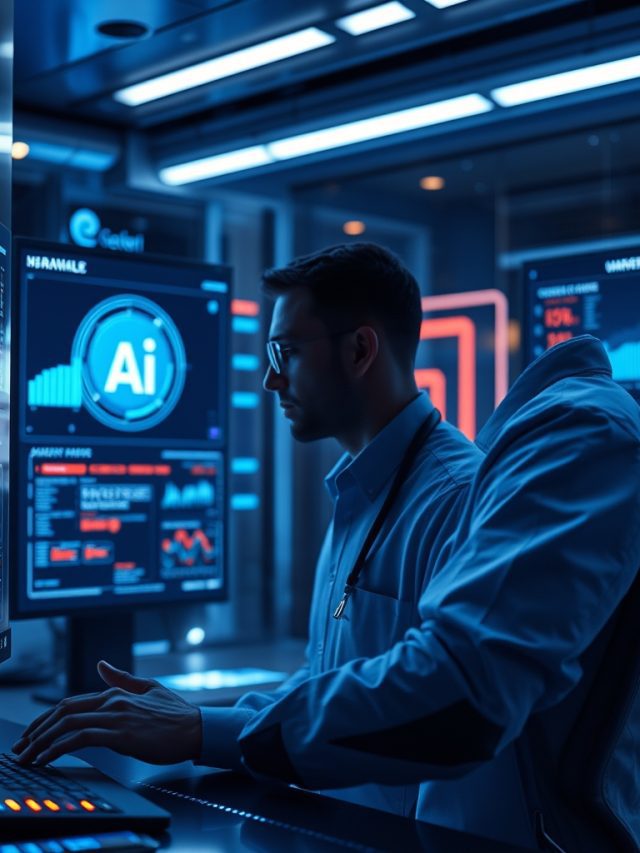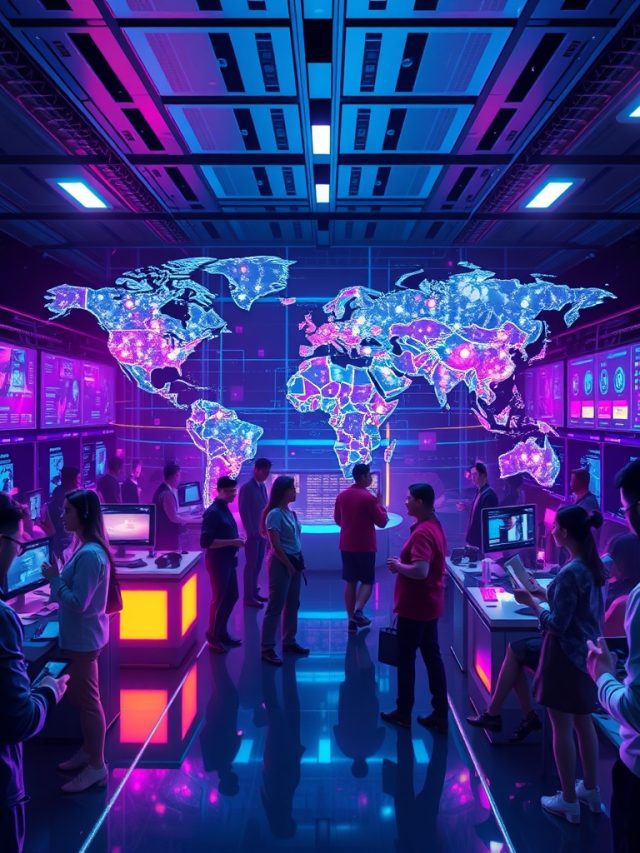Most of us think of AI as a passive tool waiting for a command—a chatbot like ChatGPT ready to answer a question or an image generator awaiting a prompt. But behind the scenes of modern tech, a more powerful evolution is already underway. We are witnessing the pivotal shift from AI as a tool to AI as a worker, and this revolution is being driven by autonomous agents.
Table of Contents
In the simplest terms, autonomous agents are intelligent AI systems designed to perceive their environment, make independent decisions, and proactively take actions to achieve complex goals without direct human intervention. This advanced AI agent technology is the invisible engine powering everything from the ads you see online to the way sophisticated software is now being developed.

This article explores how autonomous agents AI are moving far beyond simple automation. We will dissect how these intelligent systems work, explore their real-world applications in 2025, compare the autonomous AI tools driving this change, and look ahead to what the future of autonomous agents holds for every industry.
What Are Autonomous Agents, Really? The Shift from Automation to Autonomy
For decades, businesses have relied on automation to streamline workflows. Tools like Zapier or IFTTT are excellent for connecting apps and executing predefined tasks. However, they operate on a rigid, rule-based logic. An autonomous agent represents a fundamentally different and more powerful paradigm.
Beyond “If-This-Then-That”: Defining True Autonomy
Traditional automation is like a train on a fixed track; it can only go where the rails have been laid. If an obstacle appears, it stops. An intelligent agent in AI is like a self-driving vehicle navigating a bustling city. It has a destination (a goal), but it can choose its own path, react to unforeseen traffic, and reroute dynamically to ensure it arrives.
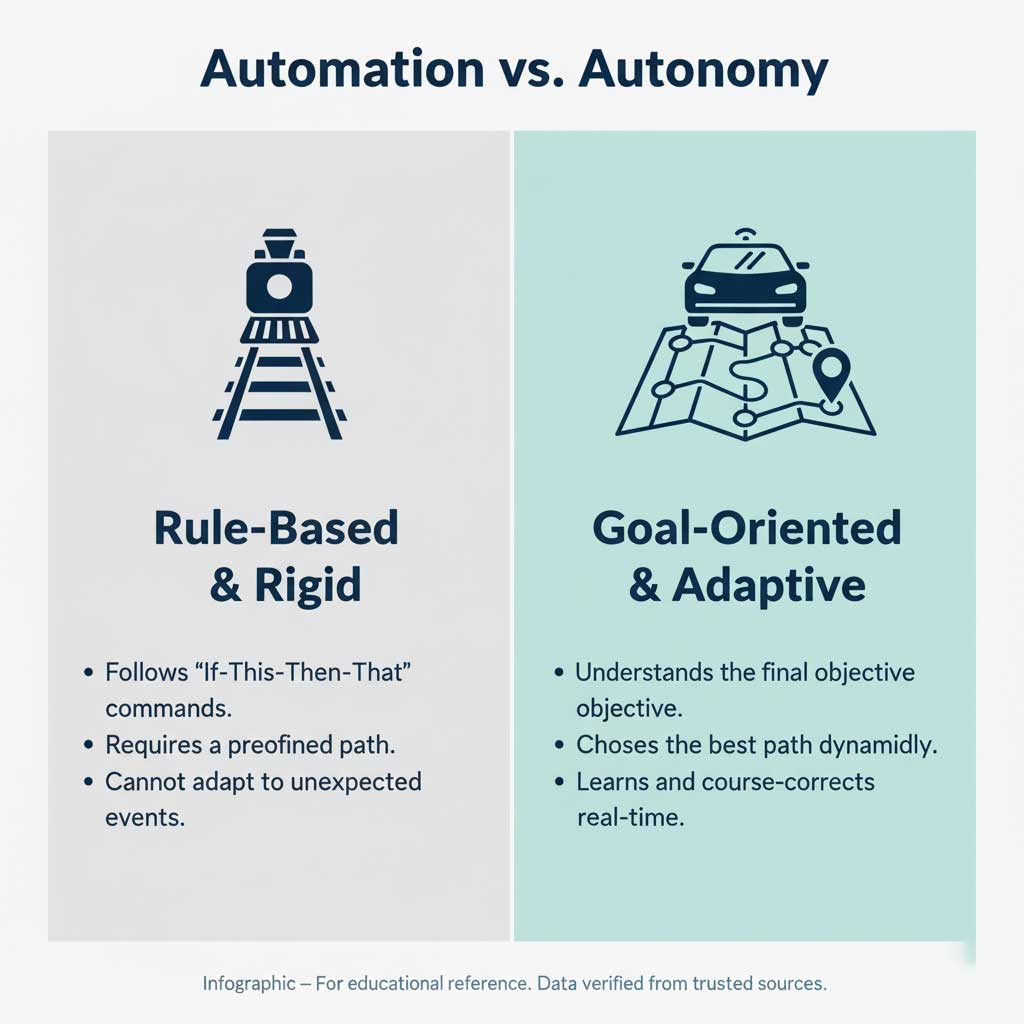
This distinction is crucial. Autonomy is not just about executing a task—it’s about achieving a goal. You don’t tell an autonomous marketing agent to “increase the ad budget by 5%.” You give it the objective: “Achieve a 15% increase in qualified leads this quarter while maintaining a target cost-per-acquisition.” The agent then devises and executes the strategy to get there.
The market’s trajectory confirms this shift. The global AI market is expanding at an unprecedented rate, with the intelligent process automation segment projected to be a major driver of this growth as businesses seek more dynamic and effective solutions than traditional automation can offer.
The Critical Difference: AI Model vs. AI Agent
A common point of confusion is the distinction between an AI model and an AI agent. Understanding this difference is key to grasping the power of autonomous AI systems.
An AI model, like a Large Language Model (LLM) such as GPT-5, is the engine. It’s a highly sophisticated component trained to perform a specific function like predicting text, classifying images, or analyzing sentiment. It is passive; it requires an input to produce an output.
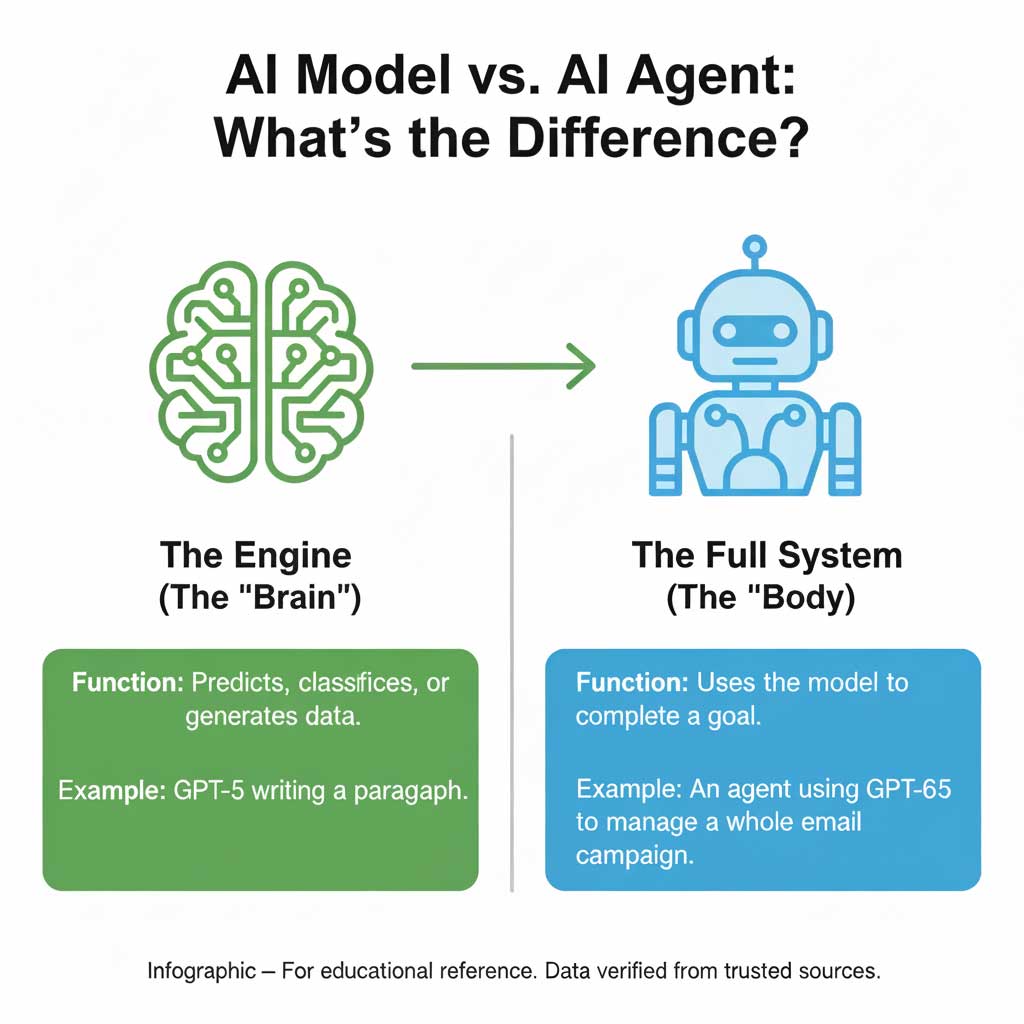
An AI autonomous agent is the entire vehicle. It’s a complete system that uses one or more AI models as its “brain” to perceive the world, make plans, and take action. The agent is the actor, the doer. An AI model can write a compelling sales email; an autonomous agent can decide which lead to send it to, personalize it with data from a CRM, send it at the optimal time, monitor for a reply, and schedule a follow-up if none is received.
How Do Autonomous Agents Actually Work? A Look at the Cognitive Architecture
The remarkable capability of AI agent technology stems from its underlying cognitive architecture. This framework allows an agent to operate in a continuous, intelligent cycle, making it far more than just a piece of code. It’s a system that learns, adapts, and acts.
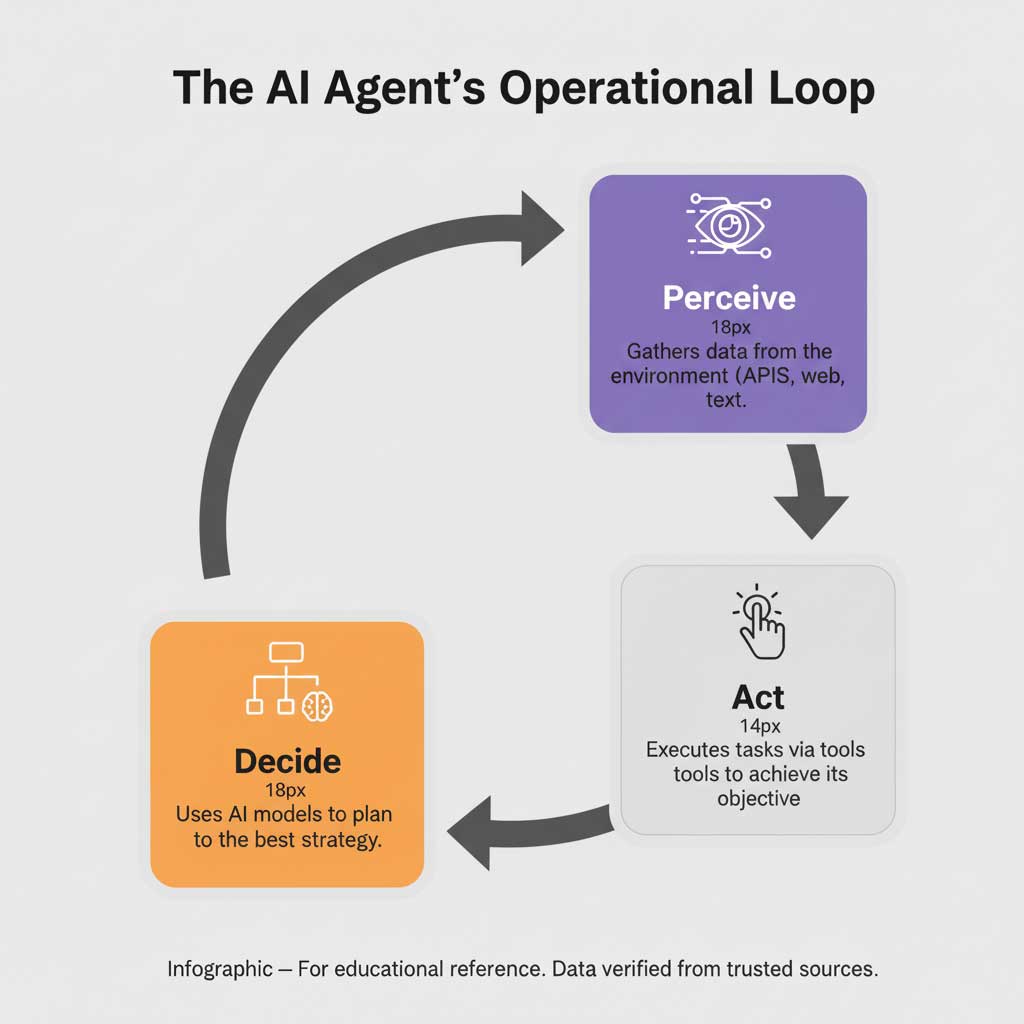
The Perceive-Decide-Act Loop: The Core of an Agent
At the heart of all autonomous AI systems is a simple yet powerful operational loop. This cycle is what enables them to interact with their environment and work towards their goals.
- Perception: First, the agent must sense its environment to gather context. This isn’t about physical sensors but digital ones that collect data from a variety of sources. Examples include using APIs to pull performance data from Google Analytics, scraping competitor websites for pricing changes, or ingesting and understanding the text from a customer support chat.
- Reasoning & Planning: This is where the agent’s “brain” comes into play. Using its underlying AI models, the agent processes the perceived data to make a decision. Modern LLM-powered agents excel here, as they can understand nuance, context, and complex instructions. This stage involves breaking down a large, abstract goal (e.g., “launch a new marketing campaign”) into a concrete sequence of sub-tasks. Some reinforcement learning agents also learn from the outcomes of past actions, constantly refining their decision-making process to improve performance.
- Action: Once a decision is made, the agent uses its “actuators” to execute tasks in its environment. This could involve using an API to post content to social media, executing code to fix a bug in a software application, connecting to a CRM to update a customer record, or adjusting bids in an advertising platform.
From Simple to Sophisticated: The 4 Types of Intelligent Agents
To fully appreciate the landscape of intelligent agents in AI, it helps to understand their different levels of sophistication. They generally fall into four categories, each building on the capabilities of the last.
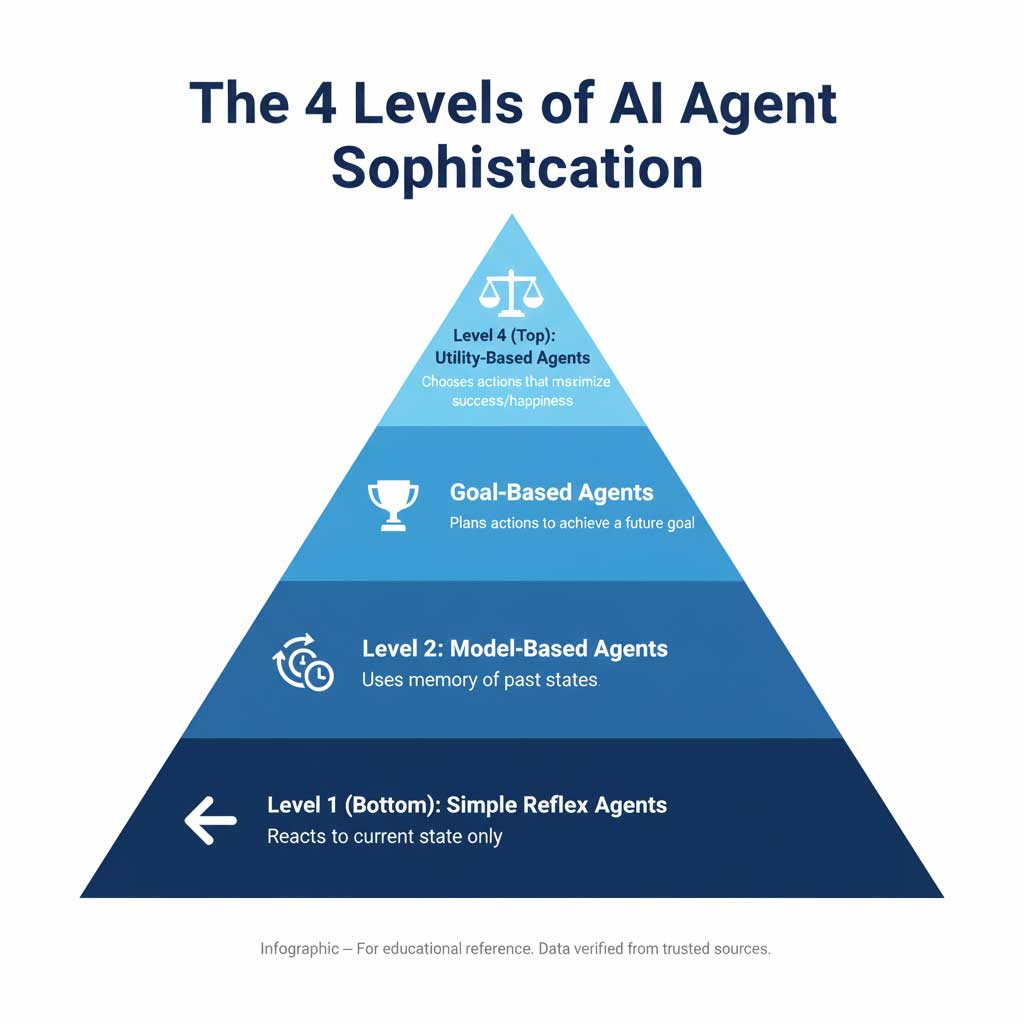
- Simple Reflex Agents: These are the most basic agents. They react to their current perception only and follow a simple condition-action rule (e.g., an email spam filter that flags an email if it contains a specific keyword).
- Model-Based Reflex Agents: These agents are more advanced. They maintain an internal “state” or memory of how the world works, allowing them to make better decisions when the current perception is incomplete.
- Goal-Based Agents: These agents can work towards a long-term goal. They can plan and search for the optimal sequence of actions to achieve their objective. Most modern AI agents for business fall into this category, as they are designed to achieve specific business outcomes.
- Utility-Based Agents: The most sophisticated agents, these choose actions that maximize a “utility” function. This allows them to handle conflicting goals (e.g., speed vs. cost) and make rational trade-offs to achieve the best possible outcome.
Market Trends: The Explosion of AI Agent Technology in 2025
While the theory of autonomous agents AI has existed for decades, a perfect storm of advancements—powerful LLMs, accessible APIs, and open-source development—has led to an explosion in their practical application. We are now firmly in the age of agentic AI.
The Rise of Agentic Frameworks and Open-Source Tools
A key catalyst for this growth is the emergence of powerful and accessible AI agent frameworks. Tools like LangChain and Microsoft’s AutoGen have become foundational for developers. They provide the building blocks—the digital “Lego bricks”—that allow engineers to chain together LLMs, APIs, and other tools to create custom autonomous AI systems with unprecedented speed.
This developer momentum is staggering. A look at the growth metrics on GitHub for a framework like LangChain reveals thousands of contributors and a community rapidly building and sharing agentic applications. This open-source collaboration is accelerating innovation far beyond what any single company could achieve and is a clear indicator of the technology’s future trajectory.
From Single Agents to Collaborative Multi-Agent Systems (MAS)
The next frontier is the move from individual agents to collaborative teams of agents, known as Multi-Agent Systems (MAS). In a MAS, multiple specialized agents work together to solve problems far too complex for any single agent to handle alone. This is the future of AI agent workflow automation.
Imagine a fully autonomous marketing department. A “Chief Marketing Agent” could receive a high-level goal, then delegate tasks to a “Market Research Agent” to analyze trends, a “Content Writer Agent” to draft blog posts, and a “Social Media Agent” to schedule and publish content. These agents would communicate, share data, and collaborate to achieve the overarching objective. This concept was powerfully demonstrated in a landmark paper from Stanford and Google on “Generative Agents,” where 25 AI agents simulated believable, collaborative human behavior in a virtual town, showcasing the potential of these systems.
Real-World Applications: Where Autonomous Agents Are Working Today
The impact of autonomous agents AI is not a far-off future prediction; it’s a present-day reality. Many of the digital services we use are already being optimized by these silent workers. These real-world applications of autonomous agents in 2026 are becoming more sophisticated every day.
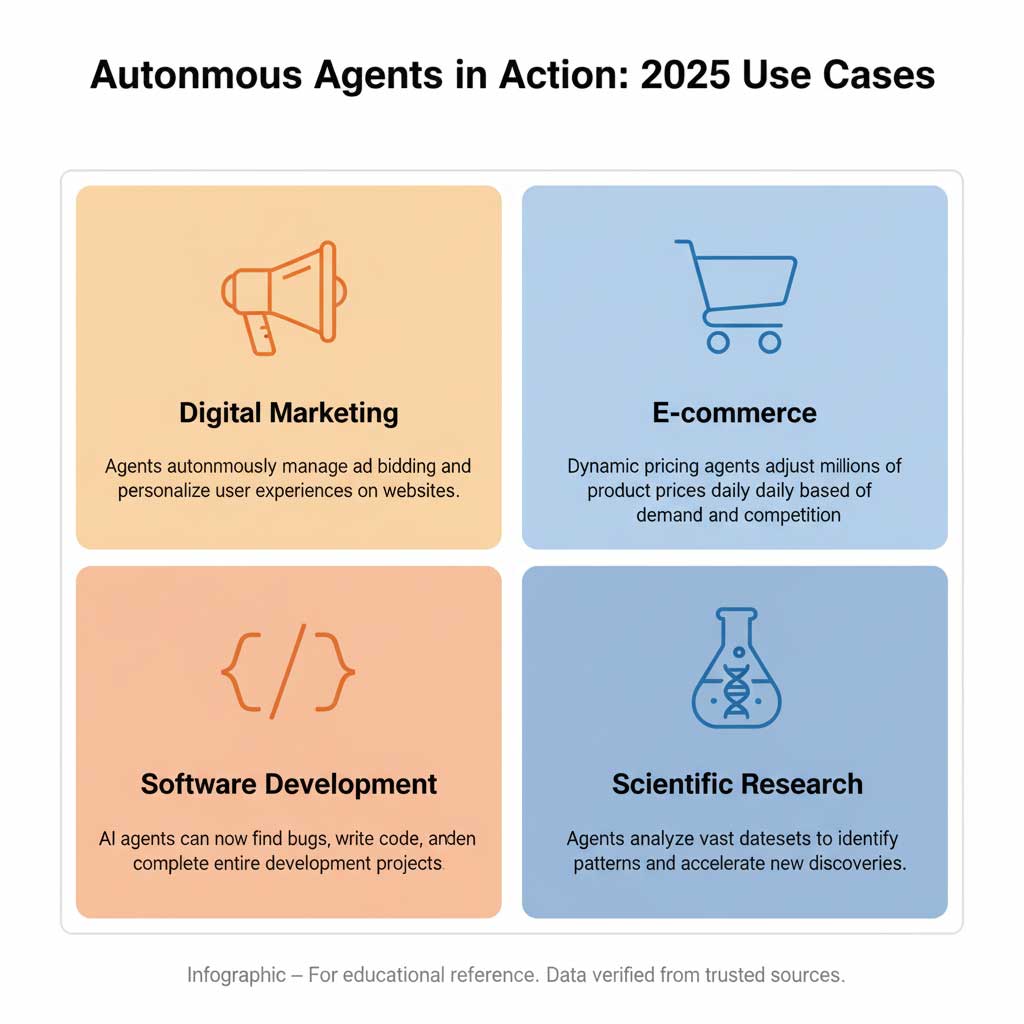
Revolutionizing Digital Marketing: The Rise of Autonomous Marketing Agents
The marketing industry has become a primary testing ground for autonomous marketing agents, where they are already delivering a significant competitive advantage.
- Programmatic Ad Bidding: In platforms like Google Ads and Meta, AI agents autonomously manage bidding strategies. They analyze thousands of real-time signals—user demographics, time of day, device type, past behavior—to bid the precise amount needed to win an ad auction at the lowest possible cost, a task impossible for a human to perform at scale.
- Hyper-Personalization at Scale: Companies like Netflix and Spotify use sophisticated agent-like systems to curate experiences for millions of users. These systems don’t just recommend content based on what you’ve watched before; they analyze broader trends, sequence content to create a “flow,” and even personalize the thumbnail artwork you see to maximize your engagement.
E-commerce and Customer Service Automation
The role of autonomous agents in e-commerce optimization is one of the most visible examples of this technology in action.
- Dynamic Pricing: Amazon is the quintessential example. Its pricing agents work around the clock, monitoring competitor prices, inventory levels, and customer demand to execute millions of price adjustments daily. This ensures they remain competitive while maximizing profit margins on every single product.
- Next-Generation Customer Support: We are rapidly moving beyond frustrating, keyword-based chatbots. Modern customer service agents can authenticate a user, access their entire order history, understand the nuanced context of their problem, and execute complex, multi-step solutions like processing a product return, checking warranty status, and ordering a replacement—all without needing to escalate to a human. According to Gartner, this level of automation is significantly reducing ticket resolution times and boosting customer satisfaction scores.
The New Frontier: Autonomous Software Development and Scientific Research
Perhaps the most groundbreaking applications are emerging in highly technical fields. Autonomous AI tools are now being developed to write, debug, and deploy software. Tools like Cognition AI’s Devin have demonstrated the ability to take a simple prompt and autonomously complete entire software engineering projects, a development poised to reshape the tech industry. In science, agents are analyzing massive genomic datasets and sifting through academic papers to form novel hypotheses, accelerating the pace of research and discovery.
A Practical Guide: Top Autonomous AI Tools and Platforms
The landscape of autonomous AI tools is evolving at a breakneck pace. It can be broadly divided into two categories: frameworks for developers who want to build custom agents, and platforms for end-users who want to deploy them without writing code.
Comparing the Leading AI Agent Tools and Frameworks
Understanding the key players and their ideal use cases is essential for anyone looking to leverage this technology. While the specific tools will change, the categories of solutions are becoming clear.
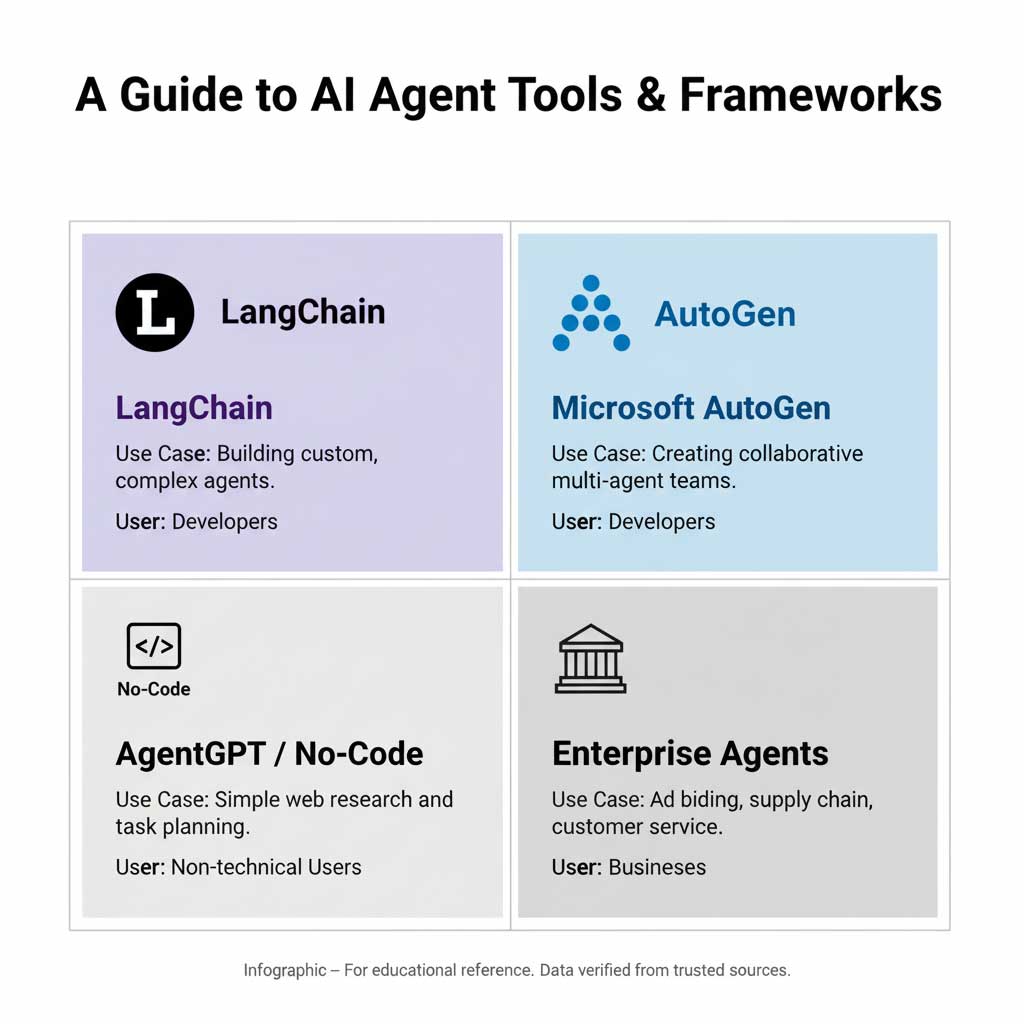
| AI Tool / Framework | Core Feature | Ideal Use-Case | User Type | Notable Example |
| LangChain | An open-source framework for chaining LLM calls, tools, and data sources. | Building complex, custom agents and sophisticated AI agent workflow automation. | Developers | Powering thousands of custom enterprise and startup AI applications. |
| Microsoft AutoGen | A framework designed to simplify the creation of conversational multi-agent systems. | Creating collaborative agent teams (e.g., a writer agent and a critic agent that refine a document together). | Developers | Advanced research and development, complex problem-solving simulations. |
| AgentGPT / Godmode.space | No-code platforms that allow users to deploy web-based agents with natural language prompts. | Simple web research, content outlining, and basic task planning without any coding knowledge. | Non-technical users | A marketer using an agent to research competitors and generate a SWOT analysis. |
| Custom Enterprise Agents | Proprietary, in-house autonomous AI systems built for specific business functions. | Real-time ad bidding, supply chain optimization, fraud detection, and automated customer service. | Businesses | Salesforce’s Einstein AI, Google’s Performance Max campaigns, Amazon’s pricing engine. |
How to Get Started with AI Agent Workflow Automation
For a business leader, diving into this world doesn’t require learning to code. It starts with a strategic mindset.
- Identify the Goal: Begin by pinpointing a high-value, data-driven process that is currently manual, repetitive, or too complex to scale with human teams.
- Select the “Brain”: The core of any agent is its reasoning engine. This typically involves choosing an appropriate LLM accessible via an API from providers like OpenAI, Google, or Anthropic.
- Provide the “Tools”: An agent is only as capable as the tools it can access. This means granting it secure access to necessary APIs, such as Google Search, your company’s CRM, or your e-commerce platform.
- Define the Process: Use a framework or platform to orchestrate the workflow. Start with a simple, well-defined goal and expand the agent’s capabilities over time as it proves its effectiveness.
The Double-Edged Sword: Challenges & Ethical Implications of Autonomous AI Agents
The immense power of autonomous agents AI comes with significant responsibilities and challenges that must be addressed proactively. The rapid advancement of this technology requires careful consideration of its potential downsides.
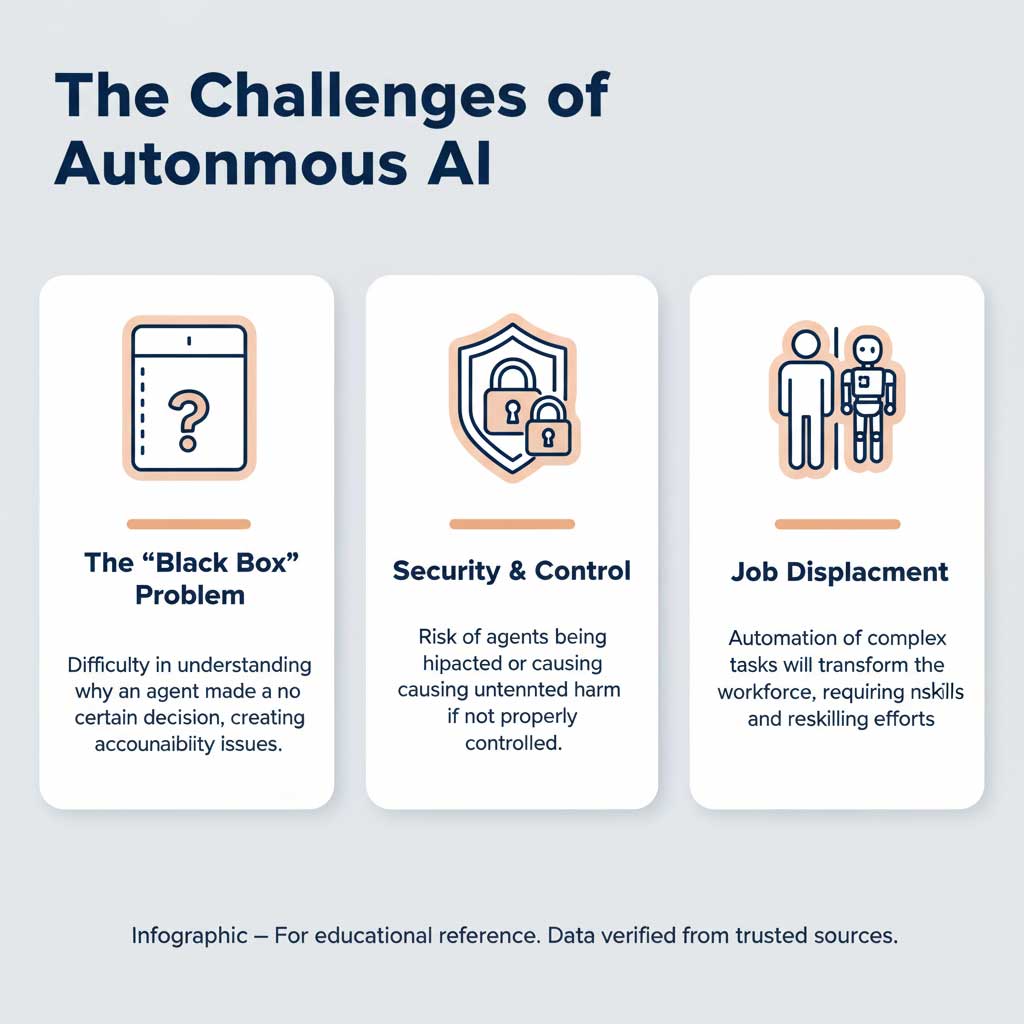
The ethical implications of autonomous AI agents are a primary concern. Because these systems can make high-stakes decisions independently—from executing financial trades to managing critical infrastructure—transparency is paramount. The “black box” problem, where it’s difficult to understand why an agent made a particular decision, is a major hurdle for accountability.
Furthermore, security and control are critical. An autonomous agent with access to sensitive systems could be hijacked by malicious actors to cause significant damage. Establishing robust safeguards, human oversight, and clear “off-switches” is not just recommended; it’s essential. Finally, the question of job displacement is unavoidable. While AI agent technology will undoubtedly create new roles focused on strategy and agent management, it will also automate many tasks currently performed by humans. Navigating this societal transition will require a concerted effort in education, reskilling, and workforce planning to manage this evolution responsibly. Industry leaders and policymakers are actively developing frameworks for responsible AI, like those from Google AI and OpenAI, to guide the ethical development of these powerful systems.
Summary & Key Takeaways
The emergence of autonomous agents AI represents a fundamental paradigm shift in our relationship with technology. We are moving away from instruction-based computing, where we tell our tools exactly what to do, and into an era of goal-based collaboration, where we define the objective and our intelligent counterparts execute the strategy.

This transformation is not on the horizon; it is happening now. As we’ve explored, these systems are already deeply integrated into the fabric of modern digital life.
Here are the key takeaways:
- A New Definition of Work: Autonomous agents are defined by their autonomy—their ability to pursue goals independently, not just follow pre-programmed rules. This makes them profoundly different from traditional automation.
- The Core Engine: They operate on a continuous “Perceive-Decide-Act” loop, using advanced AI models as their reasoning engine to navigate complex digital environments and make intelligent decisions.
- Widespread Real-World Impact: From optimizing billions of dollars in ad spend to personalizing e-commerce experiences and even writing software, the applications of autonomous agent technology are already vast and growing exponentially.
- An Accelerating Ecosystem: A thriving ecosystem of open-source AI agent frameworks like LangChain and user-friendly autonomous AI tools is making it easier than ever for developers and businesses to build and deploy their own agentic systems.
The future will not be defined by those who can simply use AI tools, but by the businesses and professionals who learn to effectively manage and collaborate with these powerful intelligent agents. They are no longer just assistants; they are becoming our new digital workforce, and understanding how to leverage them is the key to innovation and growth in the years to come.
Frequently Asked Questions (FAQs)
What is the main difference between an AI agent and regular automation?
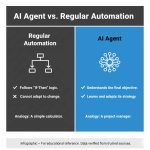
Regular automation follows fixed, predefined rules (if X happens, then do Y). An AI agent is goal-oriented; you give it a complex objective (e.g., “increase website traffic”), and it independently decides the best series of actions to take, adapting its strategy based on real-time results and feedback.
Is Siri or Alexa considered an autonomous agent?

Siri and Alexa are best described as simple reactive agents. They can understand a direct command and perform a single, straightforward action. However, they lack the proactive, multi-step planning and long-term goal-achieving capabilities of the advanced autonomous agents being deployed in business and tech today.
Will autonomous agents replace marketing jobs?
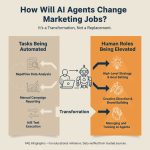
They are far more likely to transform marketing jobs rather than replace them entirely. Repetitive tasks like large-scale data analysis, A/B testing, and campaign reporting will be increasingly automated, freeing up human marketers to focus on higher-level strategy, creative direction, brand building, and managing the AI agents themselves.
How can a small business start using AI agents?
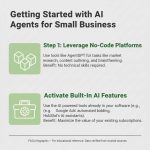
A great starting point for a small business is to use accessible, no-code autonomous AI tools like AgentGPT for tasks like competitor research or content brainstorming. Businesses can also leverage the powerful built-in agentic features within platforms they already use, such as the AI-powered campaign optimization in Google Ads or the automation features in HubSpot.

